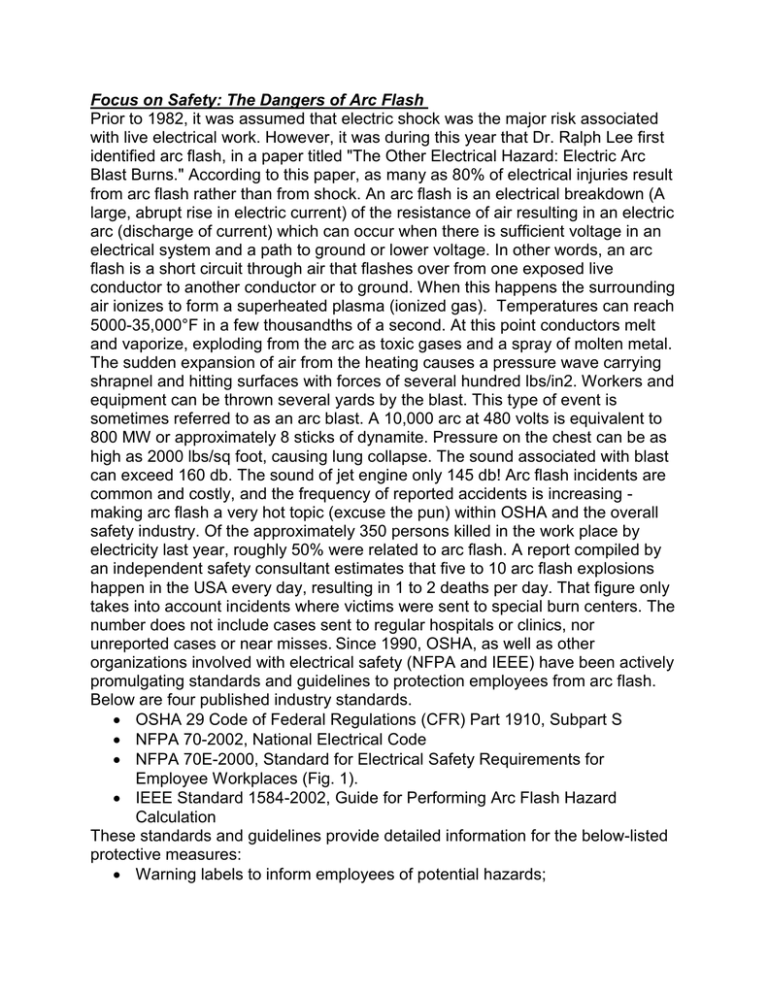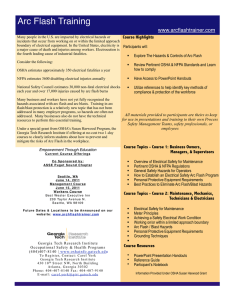4.19.11 Dangers of Arc Flash
advertisement

Focus on Safety: The Dangers of Arc Flash Prior to 1982, it was assumed that electric shock was the major risk associated with live electrical work. However, it was during this year that Dr. Ralph Lee first identified arc flash, in a paper titled "The Other Electrical Hazard: Electric Arc Blast Burns." According to this paper, as many as 80% of electrical injuries result from arc flash rather than from shock. An arc flash is an electrical breakdown (A large, abrupt rise in electric current) of the resistance of air resulting in an electric arc (discharge of current) which can occur when there is sufficient voltage in an electrical system and a path to ground or lower voltage. In other words, an arc flash is a short circuit through air that flashes over from one exposed live conductor to another conductor or to ground. When this happens the surrounding air ionizes to form a superheated plasma (ionized gas). Temperatures can reach 5000-35,000°F in a few thousandths of a second. At this point conductors melt and vaporize, exploding from the arc as toxic gases and a spray of molten metal. The sudden expansion of air from the heating causes a pressure wave carrying shrapnel and hitting surfaces with forces of several hundred lbs/in2. Workers and equipment can be thrown several yards by the blast. This type of event is sometimes referred to as an arc blast. A 10,000 arc at 480 volts is equivalent to 800 MW or approximately 8 sticks of dynamite. Pressure on the chest can be as high as 2000 lbs/sq foot, causing lung collapse. The sound associated with blast can exceed 160 db. The sound of jet engine only 145 db! Arc flash incidents are common and costly, and the frequency of reported accidents is increasing making arc flash a very hot topic (excuse the pun) within OSHA and the overall safety industry. Of the approximately 350 persons killed in the work place by electricity last year, roughly 50% were related to arc flash. A report compiled by an independent safety consultant estimates that five to 10 arc flash explosions happen in the USA every day, resulting in 1 to 2 deaths per day. That figure only takes into account incidents where victims were sent to special burn centers. The number does not include cases sent to regular hospitals or clinics, nor unreported cases or near misses. Since 1990, OSHA, as well as other organizations involved with electrical safety (NFPA and IEEE) have been actively promulgating standards and guidelines to protection employees from arc flash. Below are four published industry standards. OSHA 29 Code of Federal Regulations (CFR) Part 1910, Subpart S NFPA 70-2002, National Electrical Code NFPA 70E-2000, Standard for Electrical Safety Requirements for Employee Workplaces (Fig. 1). IEEE Standard 1584-2002, Guide for Performing Arc Flash Hazard Calculation These standards and guidelines provide detailed information for the below-listed protective measures: Warning labels to inform employees of potential hazards; Lockout/Tagout devices: to prevent unexpected re-energization of equipment while work is being performed; and Personal Protective Equipment: One source for PPE for protection against arc flash can be found in NFPA 70E. Table 130.7(C)(9)(a) lists a number of typical electrical tasks at various voltage levels and recommends the category of PPE that should be worn. While safety products are readily available, many companies make the mistake of thinking that just by purchasing them and providing them to their work force, their employees shall be properly protected. However, having the proper PPE available may be useless unless workers understand how to use them as well as knowing their limitations. Similarly, a warning label means little if employees don't have the training to treat hazards with the care they require. Therefore when in doubt, use a SAFETY PAUSE and contact your S&H representative. He/she may not know the answer, but they will find the right subject matter expert who can provide the appropriate information. Electricity and arc flash are serious hazards and should never be taken lightly. Robert Brounstein, Corporate Director Safety & Health, TerranearPMC


